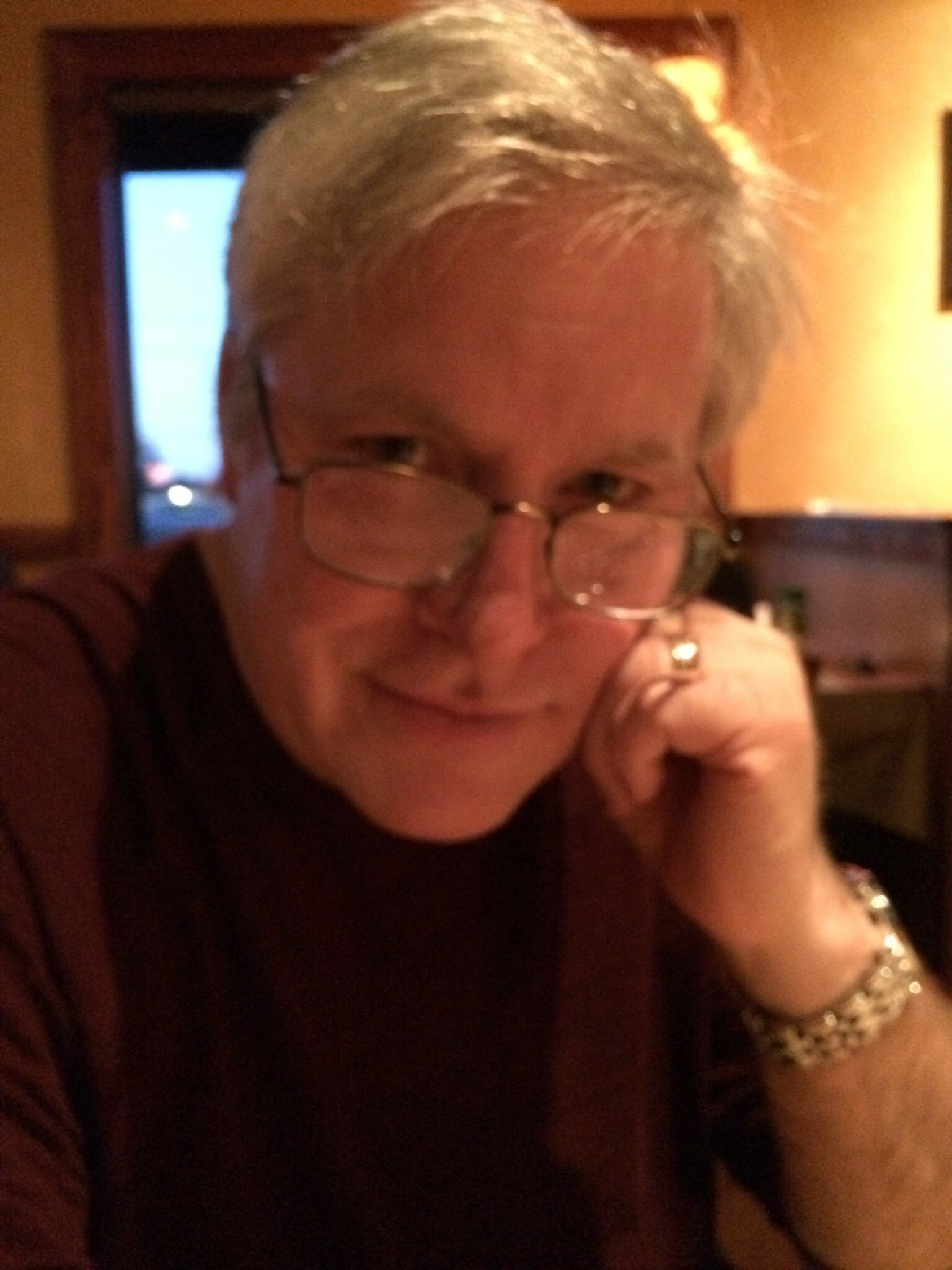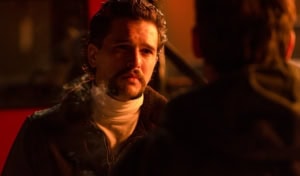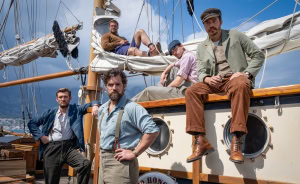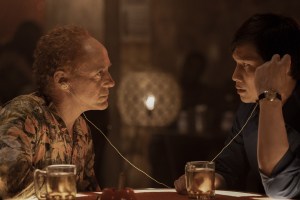When it comes to diverse storytelling, Max Allan Collins has it pretty much mastered. Whether it be Noir Mysteries, Graphic Novels, Comics, Comic Strips or Film Novelizations, Max has been there, done that. Along the way, he has worked on some of film’s A-List titles, writing adaptations of films like Saving Private Ryan, Air Force One and American Gangster. If that wasn’t enough, his Road to Perdition Graphic Novel series was adapted into the film starring Tom Hanks. Sounds like a lot, doesn’t it? But Max isn’t done by any means.
Recently, he partnered with NeoText and talented artist Fay Dalton for the first of three mystery novellas: Fancy Anders Goes to War. This exciting noir based digital book will release on October 5th. But fortunately for us, and as busy as Max is, he still found some time to talk to us for a bit. So let’s welcome Max Allan Collins to GVN’s Talking Comics Interview.
Storytelling Beginnings
GVN: Thank you so much for sharing a bit of your time, Max. So, let’s start where most good stories have their genesis, at the beginning. When did you first take an interest in writing and who were the writers that inspired you to consider that as a career?
MAC: Storytelling has been with me literally longer than I can remember. I was an only child and part of the first generation to grow up with television, so I’m sure that’s part of it. The George Reeves Superman show is one of my earliest memories. And my mother used to read Tarzan stories to me at bedtime, and was the one who turned me on to Dick Tracy comic books when I was about five or six.
Initially I wanted to draw comics and there are examples of my home-made comics going back before I could read, where I’ve filled speech balloons with gibberish – of course, some might say I still do that. I mentioned Tarzan, so Edgar Rice Burroughs was an early influence. Growing up I loved the Sherlock Holmes stories and the Saint by Leslie Charteris. By early junior high I was reading the great noir novelists – Dashiell Hammett, Raymond Chandler, James M. Cain, Mickey Spillane. Still my favorites.
Exploring Options
GVN: You have a very diversified bibliography with novels, short stories, comics and film and television adaptations. How many of these different genres did you explore on your own and how many were the result of someone else’s pitch for you to write?
MAC: That’s an insightful question. Mostly I have been driven by my own interests, which have largely been in the area of crime and mystery fiction, with occasional horror and sometimes science-fiction. Definitely a genre guy. But for about twenty years in the middle of my career, I got known as a writer who could handle movie novelizations and TV tie-ins, the latter being original works using the characters and concepts of a popular TV show. I was very lucky because I mostly got really good properties to deal with.
Movie Novelizations
For example, among the screenplays I was given to make novels out of were Saving Private Ryan, In the Line of Fire, Air Force One, and American Gangster. Quality material. Some of the lesser stuff was just fun – like the three Mummy movie novelizations, Maverick, and Waterworld. Often I would have to find a window into the work – The Scorpion King looked like it would be a drag until it occurred to me to approach it like an Edgar Rice Burroughs novel. Movie novels allowed me to work in genres that weren’t just mystery/crime – science fiction, horror, war, even a comedy like The Pink Panther. That was very good for me. Helped me grow.
Most of the TV tie-in novels, which were original stories, were more in my wheelhouse. I did all the CSI stuff for five years, novels, video game dialogue, graphic novels, even jigsaw puzzles, working with my frequent collaborator Matthew Clemens. Matt and I also did Criminal Minds, Bones and Dark Angel, the latter being science-fiction of course and something we had a really good time doing.
Attention to Details
GVN: One of the strengths of your work is your attention to detail no matter the subject matter. How much research do you undertake before taking on a story based on a specific historical genre?
MAC: Thanks for that. Research is a constant with me, but it does vary. There’s more research with the Nathan Heller novels because those are real crimes and the level of research has to rival a non-fiction account. But Fancy Anders requires a lot of digging, because if I don’t give you a sense of what an aircraft plant during the war was like, the story isn’t going to work for you. And it’s more than settings – it’s attitudes, it’s language, it’s fashions. Doing a story like this well requires taking the reader on a time machine.
For Fancy Anders Goes to War, I had all sorts of research material, but a memoir written in the forties by two women who worked for a summer at an aircraft plant – school teachers – was absolutely vital.
For the next novellas, Fancy Anders For the Boys, I had to find everything available on the Hollywood Canteen as well as material on a real murder I was using to base my fictional murder on. And for Fancy Anders Goes Hollywood, I had to know everything about the Warner’s lot – which was a small city. Let’s just say maps were required.
Writing Comics
GVN: When you started writing for comics, did it require any change to your writing process?
MAC: I was a comics fan since early childhood – a nerd long before it became fashionable. In high school, I was the guy who read comics and who wanted to be a cartoonist, passing his home-made stuff around. The drawing side fell away when I got seriously into reading Hammett and Chandler and Spillane, but I never lost my love for comics. My first mystery novels – Hard Case Crime has the first two collected as Two for the Money – feature a sidekick character who is a comics fan and aspiring cartoonist.
Being a mystery writer who seemed to know something about comics got me invited to try out for the Dick Tracy strip, to take over the writing when creator Chester Gould retired. My first novel was in 1973 and that was 1977, so comics came calling early on in my career. Writing them was never a problem. Second nature.
The Road to Perdition
GVN: Wow, Replacing Chester Gould on Dick Tracy? No pressure there. Talent and good fortune intertwine. Speaking of good fortune, your Road to Perdition comic series ended up as a film adaptation starring Tom Hanks. Did you even perceive of such a thing when you originally worked on the graphic novel?
MAC: Of course you always dream a book will be made into a movie. A lot of my stuff has been optioned, but only a handful of times have those options turned into actual movies or TV shows. I remember on the set of Road to Perdition, when I met Tom Hanks, he said, “Congratulations,” as if I’d won the lottery. I kind of had.

Fancy Anders Goes to War
GVN: Your latest work is a page-turning novella for NeoText entitled Fancy Anders Goes to War. What was the inspiration for this 40’s-based Detective thriller?
MAC: Frankly, I was reflecting on how different the current politically fractured America is compared to World War Two America, where the country was unified. Also, historical mysteries are a specialty of mine, but I’d never really done 1940s Golden Age Hollywood. And how women stepped up to be part of the war effort in those years was a natural way to do a strong female protagonist.
Terry Beatty and I did Ms. Tree, who was one of the tough female private eyes of modern comics and for that matter fiction, back in the ‘80s and ‘90s. That work is being collected in lovely trade paperback archival volumes from Titan. Ms. Tree was from a middle-class background and was in her mid-thirties. So I wanted to make the female protagonist here a substantially different character, not a re-fry of Ms. Tree.
Fancy Anders Private Eye
Fancy sort of presented herself, full-blown, when I started thinking about the ‘40s period. She would be young, fresh out of college, and from money, her father the head of a very successful L.A. private investigative agency, her mother a social butterfly, a real High Society diva. And Fancy would be pulled between them, with a strong preference for her father. She’d be a wild child, into fast-moving vehicles and shooting and flying, a beautiful tomboy equally at home at a fancy-dress ball or a sketchy roadhouse. Smart and brave and confident, but not street savvy, meaning she will make mistakes. How will she relate to the working-class women of assorted ethnicities at the defense plant? It was a time when diversity came into play almost accidentally due to the manpower shortage.
The Talented Fay Dalton
GVN: You have collaborated with talented artist Fay Dalton. She absolutely killed it with such period perfect illustrations. How did you get connected with Fay?
MAC: Fay had done covers for two of my serialized graphic novels for Titan – Quarry’s War and Mike Hammer: The Night I Died. I thought she’d be perfect for Fancy. Initially she was just going to do the cover, and the notion of someone doing interior art was just being kicked around. I thought it would bring the right kind of retro feel – the old pulps were illustrated heavily, adventure novels like Treasure Island had color plates, magazines like The Saturday Evening Post in the forties had great illos. My wife Barb, who I co-write the cozy Antiques mystery novels with, always talks about reading the older editions of Nancy Drew novels that had cars with running boards and forties fashions, something that made reading them years later special. She hated it, as a kid, when they updated those books and illustrations.
This slideshow requires JavaScript.
Color vs. Black and White
When Fay delivered the cover of Fancy Anders Goes to War, I suggested we open each chapter with a full-page illustration to set the mood and tone. Fay’s black-and-white roughs – which are never rough at all – had a noir feel that initially had me voting for black-and-white. But her color work was so strong, we couldn’t resist. A few of the illos are black-and-white with a dab of color, which has a great noir impact.
The physical edition of Fancy Anders Goes to War will have the illos in black-and-white. One day we hope a publisher will bring out a larger-size print edition collecting all three novellas with Fay’s wonderful art in full color. By the end of the trilogy, Fay will have done over 30 full-page illos. She has done the cover for my next book too, The Many Lives of Jimmy Leighton, co-authored by SCTV great Dave Thomas. It’s also a NeoText project and coming out soon.
Previews of Books 2 and 3
GVN: Big fan of Dave Thomas. Sounds like another book for us to check out when it comes out. So you touched on your other two books in the Neotext Fancy Anders Trilogy. Can you give us a hint (if possible) of what readers might expect in the next of the series?
MAC: Sure. In Fancy Anders For The Boys, we go to the Hollywood Canteen, which was a sort of unofficial USO club run by the movie studios, where soldiers and sailors were served soft drinks and sandwiches by famous actors and got to dance with famous actresses. One of the hostesses is murdered – and that’s drawn from real-life, actually – which is why Fancy goes undercover there. In Fancy Anders Goes Hollywood, a movie is based on the Hollywood Canteen – and that’s real – and Fancy is an on-set extra.
Following Max Allan Collins
GVN: Thank you so much for talking to us Max. Before I let you go, where can fans go to follow you? Whether it be on the web or on social media?
MAC: Every Tuesday morning I post an update/blog at maxallancollins.com. It’s news about my various projects, movie reviews, essays on writing, all sorts of things, including links to reviews of my work and articles and interviews like this one.

Senior Writer at GeekVibesNation – I am a 50 something child of the 70’s who admits to being a Star Trek/Star Wars/Comic Book junkie who once dove head first over a cliff (Ok, it was a small hill) to try to rescue his Fantastic Four comic from a watery grave. I am married to a lovely woman who is as crazy as I am and the proud parent of a 18 year old boy with autism. My wife and son are my real heroes.







